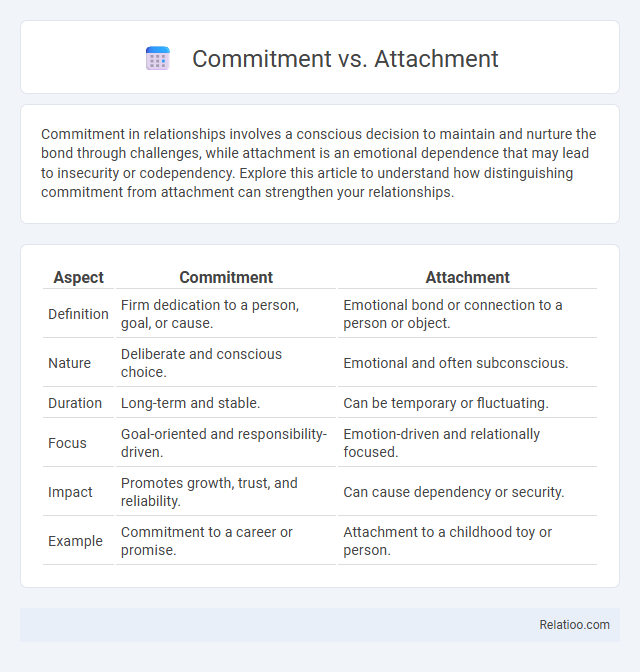Commitment in relationships involves a conscious decision to maintain and nurture the bond through challenges, while attachment is an emotional dependence that may lead to insecurity or codependency. Explore this article to understand how distinguishing commitment from attachment can strengthen your relationships.
Table of Comparison
| Aspect | Commitment | Attachment |
|---|---|---|
| Definition | Firm dedication to a person, goal, or cause. | Emotional bond or connection to a person or object. |
| Nature | Deliberate and conscious choice. | Emotional and often subconscious. |
| Duration | Long-term and stable. | Can be temporary or fluctuating. |
| Focus | Goal-oriented and responsibility-driven. | Emotion-driven and relationally focused. |
| Impact | Promotes growth, trust, and reliability. | Can cause dependency or security. |
| Example | Commitment to a career or promise. | Attachment to a childhood toy or person. |
Understanding Commitment: A Definition
Understanding commitment involves recognizing it as a deliberate and ongoing promise to uphold responsibilities and maintain trust within a relationship. Unlike attachment, which often stems from emotional dependence, commitment reflects conscious dedication to shared goals and values. Your ability to differentiate between these concepts strengthens relationship dynamics by fostering reliability and mutual respect.
Defining Attachment in Relationships
Attachment in relationships refers to the emotional bond that connects individuals, characterized by feelings of security, trust, and dependency. It often stems from early experiences and influences how people seek closeness, respond to separation, and manage intimacy in adult relationships. Unlike commitment, which emphasizes a conscious decision to maintain a relationship, attachment is a dynamic psychological process shaping emotional responses and connection patterns between partners.
Key Differences Between Commitment and Attachment
Commitment involves a conscious decision to maintain a relationship through trust, responsibility, and long-term goals, while attachment is an emotional bond often driven by dependency and comfort. Your commitment fosters growth, stability, and mutual support, whereas attachment may lead to clinginess or fear of separation. Understanding these distinctions helps you build healthier, more balanced partnerships.
The Psychology Behind Commitment
Commitment in psychology involves a conscious decision to maintain a long-term relationship despite challenges, grounding itself in trust, loyalty, and shared goals. Unlike attachment, which often stems from emotional bonds and dependency, commitment is characterized by a deliberate investment in the relationship's future. Partnership emphasizes mutual cooperation and equality, with commitment serving as the psychological foundation that fuels sustained effort and resilience within the partnership dynamic.
The Emotional Dynamics of Attachment
The emotional dynamics of attachment involve deeply rooted feelings that can influence your sense of security and vulnerability within relationships. Commitment often reflects a conscious decision to maintain a bond, while attachment is driven by emotional needs and dependency patterns formed through early experiences. Partnership thrives on mutual respect and shared goals, distinguishing it from attachment's emotional dependency and fostering healthier, balanced connections.
Signs of Healthy Commitment
Healthy commitment in relationships is characterized by consistent communication, mutual respect, and trust, ensuring both partners feel valued and understood. You can recognize this commitment when conflicts are resolved with empathy and both individuals actively work towards shared goals without losing their personal identities. This contrasts with attachment, which may rely on dependency, and partnership, which emphasizes collaboration but may lack the deep emotional investment present in commitment.
Indicators of Unhealthy Attachment
Unhealthy attachment manifests through excessive dependence, anxiety about separation, and inability to set boundaries, which undermines personal growth and emotional stability. You may notice controlling behaviors, frequent jealousy, and a fear of abandonment that strain relationship dynamics. Recognizing these indicators is crucial to differentiate between commitment, healthy attachment, and toxic bonds in any partnership.
Commitment’s Role in Long-Term Relationships
Commitment in long-term relationships serves as the foundational element that fosters stability and mutual growth, distinguishing it from mere attachment or casual partnership. Your dedication to commitment involves consistent effort, trust, and the willingness to navigate challenges together, which strengthens emotional bonds over time. Unlike attachment, which can be based on dependency, or partnerships that may focus on convenience or shared goals, commitment ensures a deeper, enduring connection built on loyalty and resilience.
How Attachment Styles Affect Relationship Success
Attachment styles profoundly influence relationship success by shaping how individuals connect and respond to their partners. Secure attachment fosters trust, effective communication, and emotional intimacy, which are key to commitment and healthy partnerships. In contrast, anxious or avoidant attachment styles often lead to misunderstandings, emotional distance, or dependency, undermining long-term relationship stability and satisfaction.
Building Commitment Over Attachment for Growth
Building commitment over attachment fosters sustainable growth by focusing on shared goals and mutual respect rather than emotional dependence. Commitment promotes accountability, encouraging you to invest consistently in relationships or projects, which leads to long-term success. This strategic approach strengthens partnerships by prioritizing dedication and trust instead of transient feelings.

Infographic: Commitment vs Attachment
 relatioo.com
relatioo.com